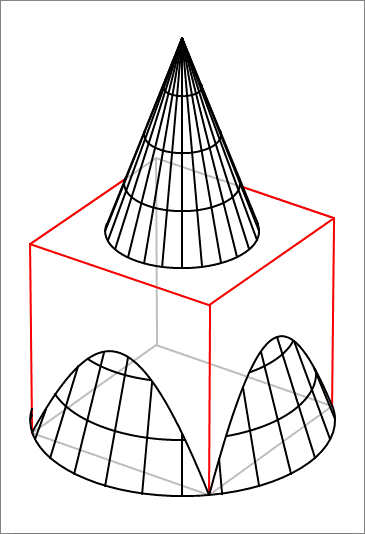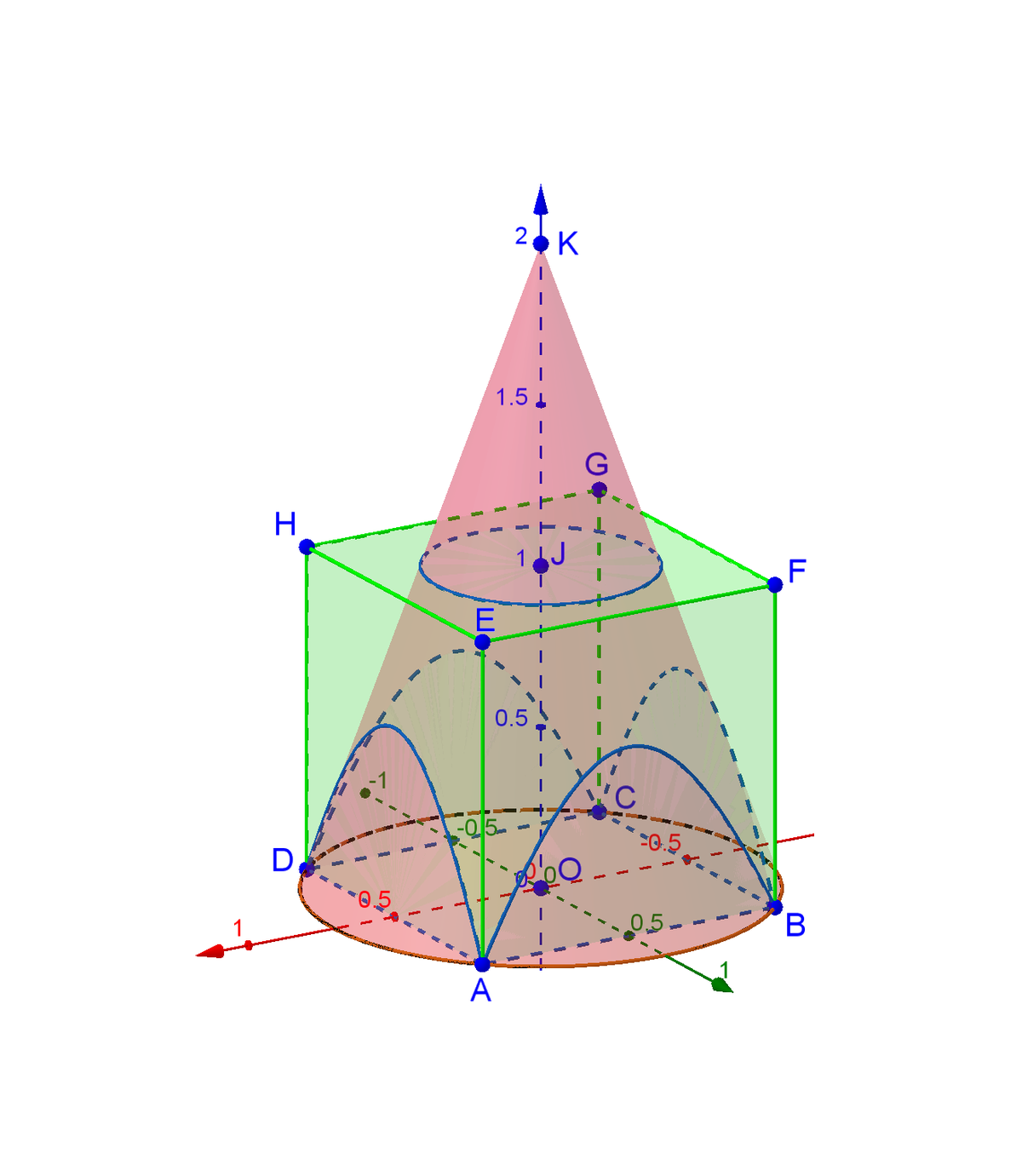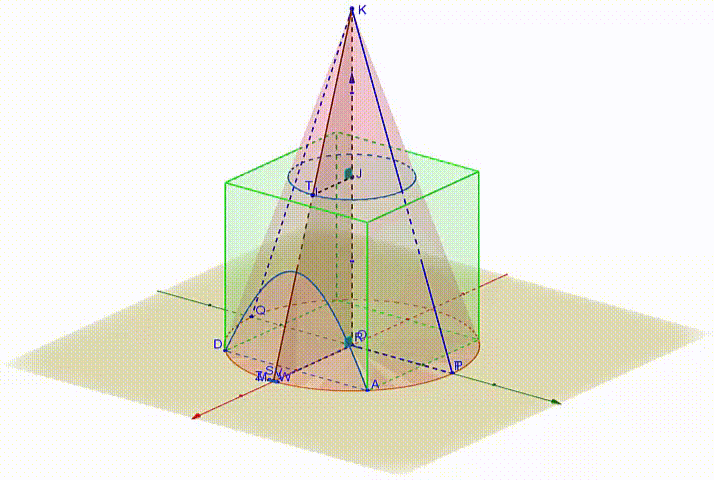Volume of Cone/Cube
A cube of unit side length is placed on the x y plane with its base centered at the origin. In addition, a right circular cone is superimposed on the cube, such that its circular base lies flat on the x y plane as well, with a diameter of 2 , and centered at the origin as well, so that the circular edge of the cone base passes through the four vertices of the cube base. The height of the cone is 2 . Find the volume of the region in space that is inside the cone but outside the cube.

The answer is 0.2602.
This section requires Javascript.
You are seeing this because something didn't load right. We suggest you, (a) try
refreshing the page, (b) enabling javascript if it is disabled on your browser and,
finally, (c)
loading the
non-javascript version of this page
. We're sorry about the hassle.
2 solutions
 figure 1
The volume of the region in space that is inside the cone but outside the cube (
figure 1
) can be calculated by the relation
V
=
V
t
r
u
n
c
a
t
e
d
c
o
n
e
−
4
⋅
V
c
o
n
e
s
e
g
m
e
n
t
By “cone segment” we mean the part of the cone that is outside the cube, bounded by the cord
A
D
, the hyperbolic arc and the arc of the cone’s circular base that corresponds to the cord
A
D
. We proceed in calculating the volume of this segment.
figure 1
The volume of the region in space that is inside the cone but outside the cube (
figure 1
) can be calculated by the relation
V
=
V
t
r
u
n
c
a
t
e
d
c
o
n
e
−
4
⋅
V
c
o
n
e
s
e
g
m
e
n
t
By “cone segment” we mean the part of the cone that is outside the cube, bounded by the cord
A
D
, the hyperbolic arc and the arc of the cone’s circular base that corresponds to the cord
A
D
. We proceed in calculating the volume of this segment.
In the animated
figure 2
,
M
is the midpoint of
A
D
⌢
(assume
M
∈
x
′
x
) and
Z
S
W
is the hyperbolic intersection of a plane through a point
V
of
O
M
perpendicular to
O
M
. Denote
S
V
=
h
and
M
V
=
t
. The triangles
△
S
M
V
,
△
K
M
O
are similar right triangles, hence,
M
V
S
V
=
O
M
O
K
⇒
t
h
=
2
2
2
⇒
h
=
2
2
t
 figure 2
figure 2
If we project the hyperbolic segment on the y z plane the vertex of the hyperbola is projected on point R and its asymptotes are the lines K P , K Q ( figures 2 and 3 ).

figure 3
The area enclosed by a hyperbola with equation a 2 x 2 − b 2 y 2 = 1 and the line l : x = k is given by the formula A = b ⎣ ⎡ k ( a k ) 2 − 1 − a ⋅ arcosh ( a k ) ⎦ ⎤ (for a proof see here )
On the y z plane, consider a 2D coordinate system with the origine at K and the line K O as the x-axis (positive direction the direction of K O ). In this setting, line l has equation x = 2 .
Moreover,
a
=
K
R
=
K
O
−
h
=
2
−
2
2
t
,
b
=
R
T
=
R
S
=
O
V
=
O
M
−
M
V
=
2
2
−
t
Substituting we get A = ( 2 2 − t ) ⎣ ⎡ 2 ( 2 − 2 2 t 2 ) 2 − 1 − ( 2 − 2 2 t ) ⋅ arcosh ( 2 − 2 2 t 2 ) ⎦ ⎤ Now, the volume of the cone segment is V c o n e s e g m e n t = 0 ∫ 2 2 − 1 A ⋅ d t = 0 ∫ 2 2 − 1 ( 2 2 − t ) ⎣ ⎡ 2 ( 2 − 2 2 t 2 ) 2 − 1 − ( 2 − 2 2 t ) ⋅ arcosh ( 2 − 2 2 t 2 ) ⎦ ⎤ ⋅ d t ≈ 0 . 0 3 2 3 3 6 9
Next, we go for the volume of the small cone with base
(
J
,
J
T
)
and height
1
.
The small cone is similar to the big one with base on plane
x
y
and height
2
. Since the rario of the heights is
K
O
K
J
=
2
1
, the ratio of their volumes is
8
1
.
Hence,
V
s
m
a
l
l
c
o
n
e
=
8
1
⋅
V
b
i
g
c
o
n
e
=
8
1
×
3
1
×
π
×
(
2
2
)
2
×
2
=
2
4
π
Finally, V = V s m a l l c o n e + 4 ⋅ V c o n e s e g m e n t = 2 4 π + 4 × 0 . 0 3 2 3 3 6 9 ≈ 0 . 2 6 0
The required region is the sum of five regions, the small cone on top of the cube, and four identical conical segments lying outside the cube as the figure shows. Using cylindrical coordinates, the equation of the cone is z = 2 ( 1 − 2 r ) , 0 ≤ r ≤ 2 1 . The volume of each of the four congruent regions protruding outside the cube is given by the integral
V 0 = ∫ ϕ = − 4 π 4 π ∫ r = 2 1 sec ϕ 2 1 2 ( 1 − 2 r ) r d r d ϕ
Performing the integration with respect to r the above double integral becomes
V 0 = ∫ ϕ = − 4 π 4 π ( 2 1 − 4 1 sec 2 ϕ ) − 3 2 2 ( 8 1 − 8 1 sec 3 ϕ ) d ϕ
Integrating with respect to ϕ yields,
V 0 = ( 2 1 − 3 1 ) 2 π − 2 1 + 1 2 2 ( sec 4 π tan 4 π + ln ( sec 4 π + tan 4 π )
Simplifying further, we obtain,
V 0 = 1 2 π − 3 1 + 1 2 2 ln ( 2 + 1 )
So, the required volume is
V = 3 1 π ( 2 1 ) 2 ( 2 ) ( 8 1 ) + 4 V 0 = 2 4 π + 3 π − 3 4 + 3 2 ln ( 2 + 1 )
which becomes,
V = 2 4 9 π − 3 4 + 3 2 ln ( 2 + 1 ) = 0 . 2 6 0 2